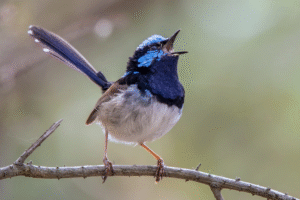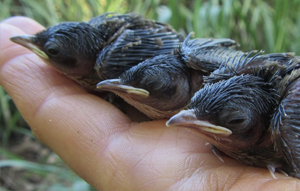Behaviour Ecology and Conservation of Birds
Peters Research Group
We use an integrative approach to understand how animals balance investment in reproduction and self-maintenance, and the consequences of this for individual success and population persistence. We study individuals throughout life in their natural environment. Consequently, our research spans several areas:
1. Cooperative breeding
The complex behavioural strategies that group living birds employ to advance their success.
2. Health, Disease & aging
What factors impinge on immune defense and damage control and how this relates to aging.
3. Global change
The impacts of climate change and other anthropogenic changes aiming to identify the environmental factors that buffer these impacts.
Our field projects involve long-term studies of purple-crowned fairy-wrens, Malurus coronatus, in the Kimberley region of north-west Australia, and a local population of superb fairy-wrens (M. cyaneus) at Lysterfield Park.
We acknowledge the Bunuba and Kija People as the Traditional Custodians of the lands where we study purple-crowned fairy-wrens. We pay respect to their past, present, and future Elders and their profound cultural and spiritual connection to the land, and the importance of the purple-crowned fairy-wren within this.
We acknowledge the Wurundjeri People of the Kulin Nation as the Traditional Custodians of the lands where we live and study. We pay respect to their past, present, and future Elders and their profound cultural and spiritual connection to the land.
We welcome, value, and respect the diversity of all people.
News in Brief
 One voice: Nest threats trigger united alarm signal in birds
One voice: Nest threats trigger united alarm signal in birds
Researchers have identified a unique vocal signal used by birds around the world to raise the alarm when a brood parasite enters their territory. Even more remarkable? Most of these birds have never met, and yet they’re all speaking the same “language”.
More than 20 species across Europe, Australia, Asia, and Africa were observed producing an eerily similar “whining” call when they spotted a brood parasitic bird.
Read the rest of the article here.
 Climate change threatens movement of endangered wren in the Kimberley
Climate change threatens movement of endangered wren in the Kimberley
Habitat degradation and erratic rainfall conditions are impacting the movement of birds through northern Australia’s fragmented landscape, a new study conducted at Mornington Wildlife Sanctuary on Bunuba Country has found. Analysing 17 years of data about the movement of nearly 800 endangered Purple-crowned Fairy-wrens in north-west Western Australia, researchers from Monash University have for the first time been able to identify exactly how human-induced habitat degradation and climate change are impacting the movement of birds who live alongside creeks and rivers in northern Australia.
Read the rest of the article here.
 Spring foe, Winter friend—cooperative behaviour trends in superb fairy-wrens
Spring foe, Winter friend—cooperative behaviour trends in superb fairy-wrens
A new Proceedings B paper explores the seasonal variation in cooperative behaviour displayed by superb fairy-wrens. Lead author, Ettore Camerlenghi, tells us more.
Why do some group-living animals live in a state of conflict with neighbouring groups while other species form peaceful multilevel societies, where groups can interact, tolerate each other, or even cooperate? A little Australian songbird, the superb fairy-wren, might provide clues to better understand what conditions promote intergroup harmony.
Read the rest of the article here.
 Social restructuring in harsh conditions promotes cooperative behaviour in songbirds
Social restructuring in harsh conditions promotes cooperative behaviour in songbirds
The superb fairy-wrens provided an ideal system for this investigation due to their multilevel society, which undergoes seasonal restructuring.
During the breeding season, individual groups defend territories, while in the non-breeding season, these groups coalesce into larger communities. By observing their behaviour in response to distress calls during both seasons, researchers assessed how social dynamics and environmental harshness influence cooperative behaviour.
Read the rest of the article here.
 Wildfire threatens the survival of endangered purple-crowned fairy-wrens living along the rivers and creeks of northern Australia, our new research has found.
Wildfire threatens the survival of endangered purple-crowned fairy-wrens living along the rivers and creeks of northern Australia, our new research has found.
For almost two decades, we studied the fairy-wrens at a wildlife sanctuary in the far north of Western Australia. Over this time, one low-intensity fire and one high-intensity fire burnt through our study site. Both occurred late in the wet season, when fires generally burn at lower intensity.
Read the rest of theconversation article here.
 Endangered fairy-wrens survive Kimberley floods
Endangered fairy-wrens survive Kimberley floods
When ex-Tropical Cyclone Ellie inundated the Kimberley with record flooding earlier this year the region and its inhabitants experienced large-scale devastation. This included the area’s native wildlife, with mass loss of life and habitat. But now, amidst the loss, there’s some good news to share.
Read the rest of the article here.




